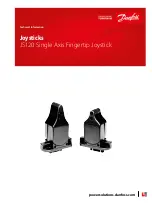
126
SPX advanced – description of parameters
SPX ADVANCED APPLICATION MANUAL
SVCH0203—October 2017 www.eaton.com
5.12.2 Master follower: Drivesynch system
DriveSynch is used to control parallel drives. Up to four
drives can be connected in parallel. The motor can be
a single winding motor or there can be several winding
motors. DriveSynch works in open loop and closed loop
motor control modes. With closed loop motor control, the
encoder feedback needs to be wired only to the master
drive.If case redundancy is required, it may be necessary to
wire the encoder feedback also to follower drives using the
double encoder option board OPTA7.
otee:
N
In a DriveSynch system, only Master drive monitoring
signals are reliable.
Only directly measured values are reliable in follower
units. Even the Output Frequency of DriveSynch
follower is not directly observed and thus may not
show actual output frequency that is controlled by
DriveSynch Master Drive.
The maximum switching frequency for the drives
using DriveSynch is 3.6 kHz. Minimum recommended
switching frequency in Open Loop control is 1.7 kHz.
Minimum recommended switching frequency in
Closed Loop control is 2.5 kHz.
The SPX control board must be VB00761 (SPX3) or
newer. OPT-D2 boards needs to VB276J or newer.
Master needs to be #1 and cannot be changed.
M
NXP
NXP
OP
T
D
2
OP
T
D
2
NXP
OP
T
D
2
NXP
O
P
T
D
2
Optical bus
Mains supply
X5 : TX1
X6 : ON
X5 : TX2
X6 : ON
X5 : TX2
X6 : ON
X5 : TX2
X6 : ON
M
Y Y
NXP
OP
T
D
2
NXP
O
P
T
D
2
Mains supply
X5 : TX1
X6 : ON
X5 : TX2
X6 : ON
Multiple winding motor
5.12.2.1 Redundancy
The units working in parallel with DriveSynch have a
high level of redundancy. The system keeps running
without interruption even if any of the follower units is
non-functional. In case of a hardware failure, the failed unit
need be isolated before the system can be restarted. The
actual level of redundancy, however, needs to be carefully
defined considering the motor, load and the requirements
of the process. The master drive unit and the fast drive to
drive optical communication has to be functional for the
DriveSynch functionality. The auxiliary power (+24V) must be
continuously provided for all the control units including the
non-functional drive units in drive synch system. It is also a
common practice to use (n+1) units, where n is the number
of required units for full functionality of the system. In this
case, the system is fully operational even if any follower is
non-functional.
Master (D1)
Follower (D2)
Follower (D3)
Follower (D4)
Parameter settings
Motor nominal voltage
Motor nominal voltage from the
motor name plate
Motor nominal voltage from the
motor name plate
Motor nominal voltage from the
motor name plate
Motor nominal voltage from the
motor name plate
Motor nominal frequency
Motor nominal frequency from the
motor name plate
Motor nominal frequency from the
motor name plate
Motor nominal frequency from the
motor name plate
Motor nominal frequency from the
motor name plate
Motor nominal current
Motor nominal current from the
motor name plate/Number of drives
in parallel using Drive Synch
Motor nominal current from the
motor name plate/Number of drives
in parallel using Drive Synch
Motor nominal current from the
motor name plate/Number of drives
in parallel using Drive Synch
Motor nominal current from the
motor name plate/Number of drives
in parallel using Drive Synch
Motor COS PHI
(motor nominal power factor)
Motor COS PHI from the motor
name plate
Motor COS PHI from the motor
name plate
Motor COS PHI from the motor
name plate
Motor COS PHI from the motor
name plate
Motor nominal power
Motor nominal power from the
motor name plate/Number of drives
in parallel using Drive Synch
Motor nominal power from the
motor name plate/Number of drives
in parallel using Drive Synch
Motor nominal power from the
motor name plate/Number of drives
in parallel using Drive Synch
Motor nominal power from the
motor name plate/Number of drives
in parallel using Drive Synch
Master follower mode
Master, DriveSynch
Follower, DriveSynch
Follower, DriveSynch
Follower, DriveSynch
Motor Control Mode
(Open Loop)
Open Loop Frequency
If used as Secondary Master: Open
Loop Frequency.
When used as Follower: no
meaning.
No meaning, internally handled.
Recommended to have same
setting as in master.
No meaning, internally handled.
Recommended to have same
setting as in master.
Motor Control Mode
(Closed Loop)
Closed Loop Speed/Torque
If used as Secondary Master:
Closed Loop Speed/Torque.
When used as Follower: no
meaning.
No meaning, internally handled
Recommended to have same
setting as in master.
No meaning, internally handled
Recommended to have same
setting as in master.
Magnetizing current
(needed only for closed loop motor
control)
Motor nominal magnetizing
current/Number of drives in
parallel using Drive Synch
Motor nominal magnetizing
current/Number of drives in
parallel using Drive Synch
Motor nominal magnetizing
current/Number of drives in
parallel using Drive Synch
Motor nominal magnetizing
current/Number of drives in
parallel using Drive Synch
Switching Frequency
Max 3.6 KHz
Same as in Master
Same as in Master
Same as in Master
Modulator Type
1, Software
Same as in Master
Same as in Master
Same as in Master
Follower Phase shift
(single winding motor)
0 degrees
0
0
0
Follower Phase shift
(multiple winding motor)
0 degrees
As per motor name plate
As per motor name plate
As per motor name plate
















































